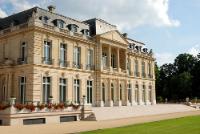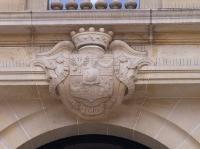General
The Château de la Muette
 Although the present Château de la Muette is modern (circa 1920) and was built at some distance from where the original château stood, the site is steeped in the history of France.
Although the present Château de la Muette is modern (circa 1920) and was built at some distance from where the original château stood, the site is steeped in the history of France.
Even the origin of the name Muette is lost in the past. It may have derived from Muete, a spelling which appears frequently up to the end of the 18th century and which signifies a pack of deer-hounds (meute); it may have come from the mues or horns which stags shed in the autumn; or again from the mue or moulting-period of hunting-hawks, or was chosen to evoke the domain’s remoteness from the royal court’s gossip and intrigue.
Whatever the origin, the name of the current Château was in some way connected with the hunting-lodge which French kings used when they hunted in the Bois de Boulogne.
A HUNTING-LODGE BECOMES A ROYAL CASTLE
 A royal hunting-lodge, the birthplace of princes of France, the residence of a succession of royal mistresses, the park where King Louis XVI and Queen Marie-Antoinette walked without guards among their people, such is the Domain de la Muette. Around 1572, this former hunting-lodge was transformed into a small royal château for Charles IX. In turn, the King gave his château to his sister Marguerite de Valois, the first wife of Henri IV. Marguerite bequeathed her château to the Dauphin, the future Louis XIII. In 1716, the Château de la Muette became the home of the Duchesse de Berry, daughter of the Duc d’Orléans, Regent of France; here she received the Tsar Peter the Great of Russia. Following her premature death, the Regent offered the château to the young King Louis XV. Ten royal children were born here between 1724 and 1734. However, the King seems to have preferred to entertain his favorites at la Muette rather than his own family.
A royal hunting-lodge, the birthplace of princes of France, the residence of a succession of royal mistresses, the park where King Louis XVI and Queen Marie-Antoinette walked without guards among their people, such is the Domain de la Muette. Around 1572, this former hunting-lodge was transformed into a small royal château for Charles IX. In turn, the King gave his château to his sister Marguerite de Valois, the first wife of Henri IV. Marguerite bequeathed her château to the Dauphin, the future Louis XIII. In 1716, the Château de la Muette became the home of the Duchesse de Berry, daughter of the Duc d’Orléans, Regent of France; here she received the Tsar Peter the Great of Russia. Following her premature death, the Regent offered the château to the young King Louis XV. Ten royal children were born here between 1724 and 1734. However, the King seems to have preferred to entertain his favorites at la Muette rather than his own family.
Respectively, the three de Nesle sisters, Madame de Pompadour and Madame Dubarry would all reside at la Muette. During this period, the Château was rebuilt by the architects Jacques and Ange-Jacques Gabriel, father and son. King Louis XVI spent the happiest days of his life at the château with his young bride, Marie-Antoinette. It was a period of honeymoon, not only with his wife, but also with his people. Louis XVI received Emperor Joseph II, Marie-Antoinette’s brother, for dinner at la Muette. It was also where the King granted a certain Antoine-Augustin Parmentier a patch of sandy ground in the northwest corner of the domain to plant potatoes, hitherto practically unknown in France.
In November 1783, from the gardens of la Muette, Pilâtre de Rozier and the Marquis François Laurent d’Arlandes made the first successful flight in a hot-air balloon, built by the Montgolfiere brothers, thus becoming the first humans to break loose from the earth’s gravity. Among the crowd who observed this feat were the royal family and Benjamin Franklin.
At the Revolution, the domain became state property. By 1792, the royal days of the Château de la Muette were over; the National Assembly decided to sell the estate to the highest bidder. The domain’s park and buildings were carved into several lots and the château itself was split into two separate wings to make the parcels more attractive to bidders. Two distinct properties, la Muette and la Petite Muette, were created.
LA MUETTE IN THE 19th CENTURY
The wing known as la Muette became the property of a well-known manufacturer of pianos named Sébastien Érard. Érard bequeathed the château to his nephew Pierre Érard. Around 1865, Pierre Érard’s widow set out to reassemble the original domain as much as possible. Later, Madame Pierre Érard reassembled the two wings of the former Muette and Petite Muette. Madame Érard bequeathed the Château de la Muette to her adopted niece Marie (Schaeffer) Érard.
Marie Érard married Amable-Charles Franquet de Franqueville, who would later be made Count de Franqueville by the Pope in 1870. Years later, ownership of the nearly-reassembled Domain de la Muette would pass into the hands of the Count’s heirs. The family decided to sell the château and the surrounding gardens, paving the way for a new upscale residential neighbourhood; the last remnants disappeared around 1926.

In 1912, Baron Henri de Rothschild purchased 22 000 m2 of land from the Count de Franqueville to build a château and surrounding park. The château would become the official Parisian residence of the Baron Henri de Rothschild, whose coat of arms is still visible above the château’s main entrance along with the Baron’s motto: Concordia, Integritas, Industria (Unity, Integrity, Diligence). The street just in front of the château bears the name of André Pascal, which was one of the Baron’s pen names.
The facade features 24 hand-carved stone effigies of male and female theatrical allegories and masks. In October 1948, the Baron’s heirs sold the château to the Organisation for European Economic Co-operation (OEEC) which established its headquarters at la Muette.
CHÂTEAU DE LA MUETTE – THE GARDENS
In 1914, Baron Henri de Rothschild organised a contest to design the most appropriate gardens for his new home. The winner was Raoul Saint-Martin, pupil of the illustrious landscape architect Achille Duchêne (1866-1947) who was the son and associate of Henri Duchêne (1841-1902).
Since 2009-2010, the garden of la Muette was reorganized and now boasts an environmentally friendly home for over 25 000 plants including 139 trees, among which are 71 lime trees.
Related Documents